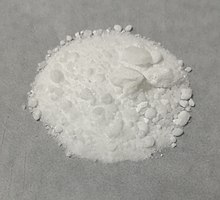Gadolinium acetate
Appearance
(Redirected from Gadolinium(III) acetate)
 | |
| Names | |
|---|---|
| Other names
Gadolinium ethanoate
| |
| Identifiers | |
3D model (JSmol)
|
|
| ChemSpider | |
| ECHA InfoCard | 100.036.534 |
| EC Number |
|
PubChem CID
|
|
CompTox Dashboard (EPA)
|
|
| |
| |
| Properties | |
| Gd(CH3COO)3 | |
| Appearance | colorless crystal or white powder |
| Density | 1.611 g·cm−3 (hydrate) |
| 9.7 g[clarification needed] | |
| Hazards | |
| GHS labelling:[1] | |

| |
| Warning | |
| H315, H319, H335 | |
| P261, P264, P264+P265, P271, P280, P302+P352, P304+P340, P305+P351+P338, P319, P321, P332+P317, P337+P317, P362+P364, P403+P233, P405, P501 | |
Except where otherwise noted, data are given for materials in their standard state (at 25 °C [77 °F], 100 kPa).
| |
Gadolinium acetate is the acetate salt of the lanthanide element gadolinium with the chemical formula Gd(CH3COO)3. It is a colorless crystal that is soluble in water and can form a hydrate.[1] Its tetrahydrate has ground state ferromagnetism.[2]
Preparation
[edit]The tetrahydrate of gadolinium acetate can be crystallized from aqueous solution by reaction of gadolinium oxide and acetic acid:[2]
- Gd2O3 + 6 HOAc + 5 H2O → [(Gd(OAc)3(H2O)2)2]·4H2O
Properties
[edit]The complex [Gd4(CH3COO)4(acac)8(H2O)4] can be obtained by the reflux reaction of gadolinium acetate and acetylacetone in the presence of triethylamine in methanol solution.[3]
References
[edit]- ^ Никольский, Б.П., ed. (1971). Справочник химика (in Russian). Vol. 2 (3-е изд., испр ed.). Л.: Химия.
- ^ a b Hatscher, Stephan T.; Urland, Werner (2003). "Unexpected Appearance of Molecular Ferromagnetism in the Ordinary Acetate [Gd(OAc)3(H2O)22]⋅4 H2O". Angewandte Chemie International Edition. 42 (25): 2862–2864. doi:10.1002/anie.200250738. ISSN 1521-3773. PMID 12833342. Archived from the original on 27 May 2020. Retrieved 1 February 2019.
- ^ Guo, Fu-Sheng; Leng, Ji-Dong; Liu, Jun-Liang; Meng, Zhao-Sha; Tong, Ming-Liang (2 January 2012). "Polynuclear and Polymeric Gadolinium Acetate Derivatives with Large Magnetocaloric Effect". Inorganic Chemistry. 51 (1): 405–413. doi:10.1021/ic2018314. ISSN 0020-1669. PMID 22145780. Retrieved 1 February 2019.
